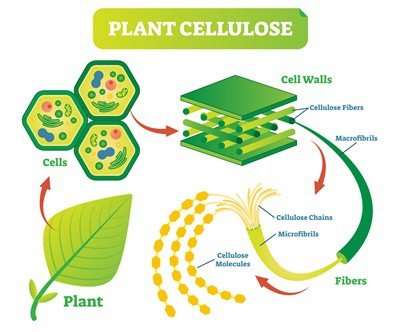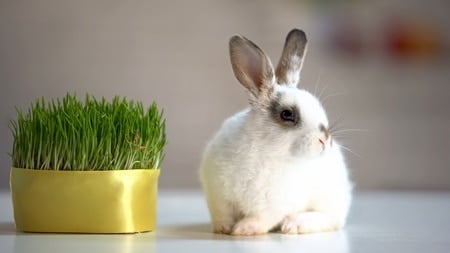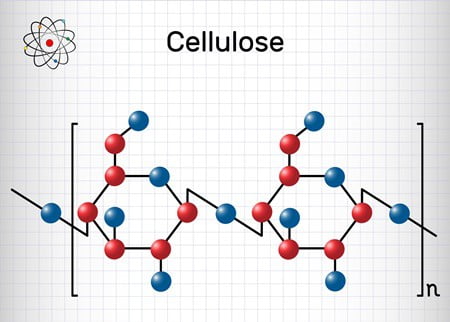The bulk of a rabbit’s diet is made up of hay and grass, which are high in cellulose. Cellulose is indigestible for humans, but all herbivores, including rabbits, can digest it. Rabbits don’t have the enzyme that digests cellulose. So how do rabbits break down cellulose in their bodies?
Most of a rabbit’s digestion takes place in a pouch at the beginning of the large intestine, called the cecum. Rabbits harbor microbes in the cecum that release the enzyme cellulase to break down cellulose.
The cecum produces nutrient-rich cecotropes that are later passed through the anus and consumed by the rabbit. Any indigestible fiber is passed from the colon as hard droppings.
What is Hindgut Fermentation?
| Part of the Gut | Digestive Process |
|---|---|
| Mouth | Food is ground up |
| Stomach | Food is mixed with acids for sterilization and enzymes |
| Small intestine | Absorption of protein, starches, and sugar |
| Cecum | Fermentation of digestible fiber/cellulose |
| Return to the small intestine | Reabsorption of nutrients |
| Large intestine | Indigestible fiber is excreted as poop |
Hindgut fermentation is a digestive process exhibited by animals with single-chambered stomachs, also called monogastric herbivores. Hindgut fermenters, such as rabbits, digest cellulose with the help of symbiotic bacteria. These bacteria found in the large intestine and cecum ferment hard-to-digest cellulose, allowing rabbits to extract vitamins and minerals.
According to BMC Genomics, small cecum fermenters have gastrointestinal tracts 10-13 times the length of their bodies. This is because these animals have a high intake of hard to digest compounds like cellulose.

Digestion from Mouth to Small Intestine
Rabbits are grazing animals that largely feed on grass, hay, and leafy weeds. These plant materials are packed with cellulose. A cellulose-rich diet can make it difficult for animals to extract nutrients. However, rabbits have a unique digestive system that allows them to digest cellulose efficiently, releasing the bulk of their nutrients.
The digestion of food in a rabbit’s body starts from its mouth. Rabbits grind their food thoroughly before swallowing it, creating a mashed-up material. This material travels down the esophagus and then the stomach, where special enzymes and acids break it down further.
From the stomach, the plant food moves to the small intestine where more enzymes break down the food further into individual nutrients. A lot of the protein, starch, and sugar are absorbed into the bloodstream from the small intestine. The enzymes in the small intestine can’t break down cellulose.
Up until this point, the digestive process is the same for most mammals. In rabbits, the colon divides the fiber into 2 types: digestible and indigestible.
Cellulose Digestion in the Cecum
Digestible fiber is dense in nutrients that are locked inside it. Instead of passing it out as waste, the colon diverts the digestible fiber to the cecum for further processing.
The remaining indigestible fiber does not contain any useable nutrients. However, it is still vital to a rabbit’s digestive process. Indigestive fiber helps carry indigested food matter through the digestive system. The colon turns this fiber into hard, spherical droppings, which are passed out as waste. These are the droppings you see in your rabbit’s litter tray.
The digestible fiber that enters the cecum is converted into cecotropes, which are chock-full of nutrients.
In rabbits, the cecum is a chamber found between the small and large intestines. The cecum contains symbiotic microorganisms, such as bacteria, protozoa, and yeast that produce cellulase. Cellulase is an enzyme that breaks down the cellulose walls of plant cells.
Rabbits need digestible and indigestible fiber for proper motility of the intestines. A diet that is too low in fiber, especially from grass and hay, and too high in carbohydrates can result in a sluggish cecum and intestine.
According to MSD, this can lead to serious diseases, such as gastrointestinal stasis (GI stasis). The Veterinary Nurse states that GI stasis is usually a life-threatening condition in rabbits.
Traveling Back to The Small Intestine
The breakdown of digestible fiber releases stored nutrients. The cecum absorbs some of these nutrients, but most of them need to travel back to the small intestine to be absorbed.
For this to happen, fermented fiber returns to the colon, where it gets coated with protective mucus. The colon then pushes out these mucus-covered droppings out of the anus. These special droppings are called cecal droppings, or cecotropes.

Cecotropes
Cecotropes are higher in water, vitamins, and protein and lower in fiber than fecal pellets that contain indigestible fiber. They look like a small bunch of moist, brown grapes. Cecotropes are commonly referred to as night droppings.
Rabbits eat the cecotropes as they’re leaving the anus, a process called coprophagy. This often just appears as if the rabbit is grooming itself. In most cases, rabbits do this in the early morning hours or during the night.
Coprophagy is a form of food recycling. Once the cecal droppings are consumed, they pass through the digestive tract just like normal food. Nutrients from the droppings are absorbed into the bloodstream via the small intestine lining. The nutrients in cecotropes are much easier to absorb as they’ve already been digested once before.
Any material that cannot be absorbed is pushed back to the colon. Again, the colon separates the digestible fiber from the indigestible fiber. The indigestible fiber turns to waste, or what most rabbit owners see as fecal droppings.
Cecal vs. Fecal Droppings
| Cecal Droppings (Cecotropes) | Fecal Droppings (Poop) |
|---|---|
| Soft and moist | Hard |
| Resemble a tight bunch of grapes | Oval or round shaped |
| Foul odor | Almost odorless |
| Brown to green | Brown to dark brown |
| Eaten from the anus | Passed out of the anus |
| Rare to be seen | Seen as poop |
Fecal droppings look different from cecal droppings. Fecal droppings are often oval in shape and harder in texture. Rabbits know that they aren’t supposed to eat their fecal droppings, so it’s the owner’s responsibility to clean them up. Fecal droppings are also almost odorless. Cecotropes are moist, often brown or green in color, and have a foul odor.
It’s rare to see cecotropes in a rabbit’s cage. Most rabbits will consume the cecotrope as soon as they expel it. This allows rabbits to repurpose eaten food for additional nutrients.
Cecotropes are not the same as poop. If rabbits didn’t eat cecotropes, they would miss out on a large number of nutrients from cellulose. In the wild, where food shortages are common, not recycling cecotropes can lead to malnutrition and death.
You may see an occasional cecotrope in your rabbit’s cage, but this is often not a cause for concern. If you see multiple cecotropes, it could mean that your rabbit’s diet is too rich in protein, or it has a serious condition.
Excessively moist or mushy cecotropes could be a sign of poor gut flora or GI stasis. This could be a result of the cellulose-poor diet.
Rabbits have a highly specialized digestive tract that allows them to break down and gain maximum nutrients from hard-to-digest plant matter. While their method of processing cellulose is incredibly efficient, sudden dietary changes, such as too many carbohydrates or too little fiber, can throw their digestive tracts completely out of balance.

